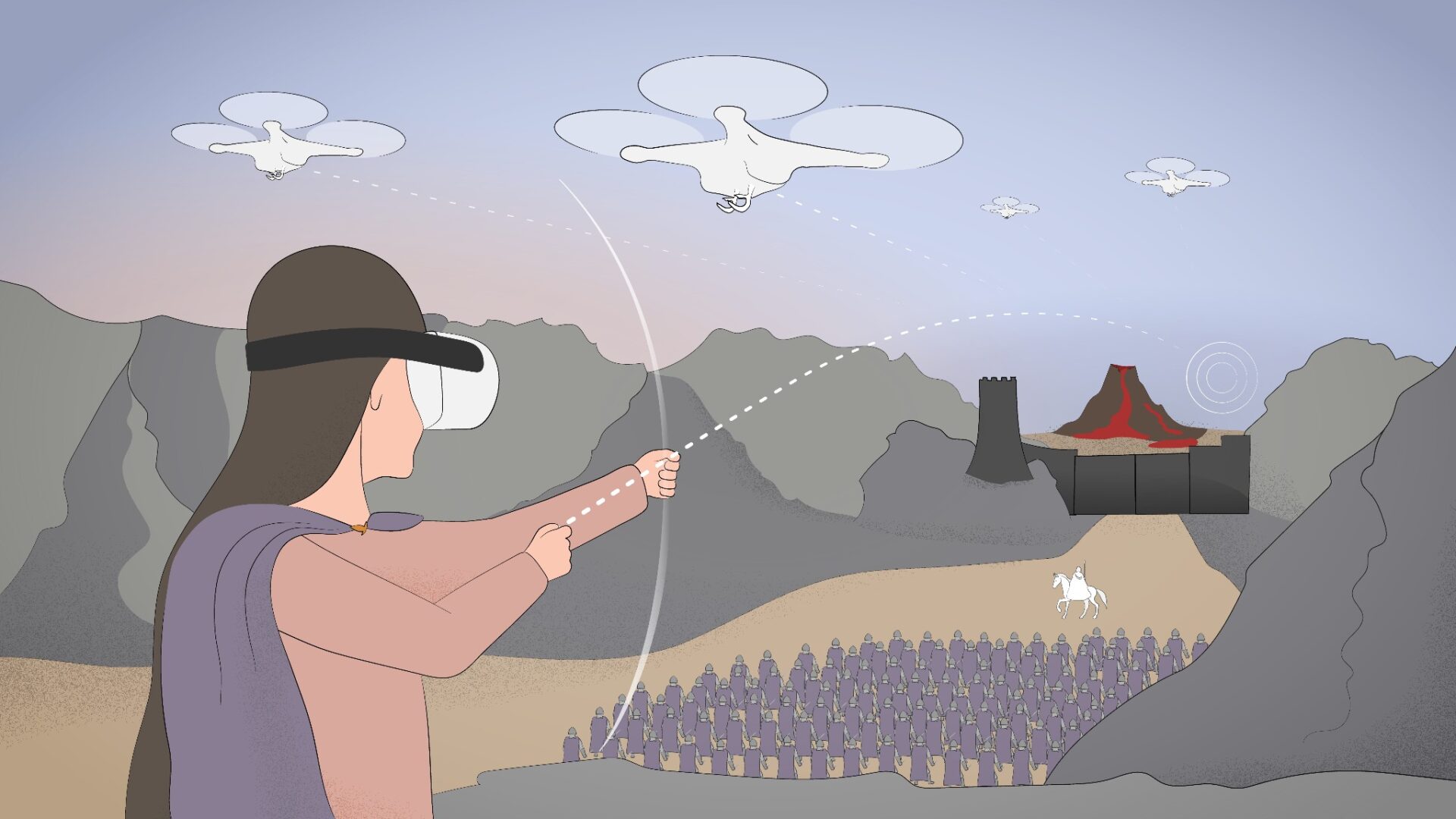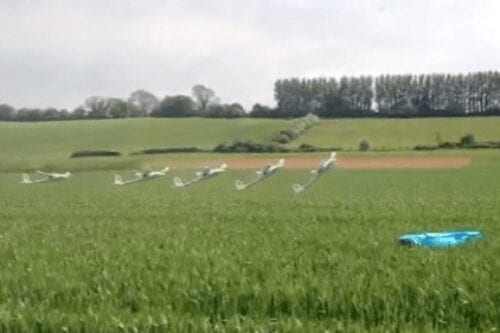
Drone archery. Credit: Pavel Odinev/Skoltech
Skoltech researchers have developed an effective — and pretty dramatic — way for positioning a swarm of rescue or research drones. The operator wears a virtual reality helmet and a tactile interface to imitate shooting a bow to guide each drone toward its intended position with a series of shots. The technique is enhanced by deep reinforcement learning, which serves to prevent the robots from colliding with each other.
The study was presented at the 21st IEEE International Symposium on Mixed and Augmented Reality
“Steve Jobs radically changed our idea of an intuitive interaction with the digital world when he championed touch screens and gestures. The goal of our research is even more ambitious in that it seeks to address the challenge of how to enable a user with no drone piloting experience to deploy an entire swarm within mere seconds,” commented the study’s principal investigator, Skoltech Associate Professor Dzmitry Tsetserukou, who heads the Intelligent Space Robotics Laboratory.
“Right now, there aren’t that many interfaces for deploying a swarm of drones,” the study’s lead author, Skoltech MSc graduate Ekaterina Dorzhieva, commented. “A joystick is convenient for controlling one drone, but once you have a whole swarm, you either need multiple operators or very complex software with code that explicitly accounts for a lot of stuff in a nonintuitive way. We offer an alternative to this.”
The alternative solution presented by the researchers from the Institute’s Engineering Center is a tactile interface proposed by Skoltech PhD student ?Miguel Altamirano Cabrera and inspired by LinkTouch, an earlier design created by Tsetserukou in Japan.
The operator (video) wears a virtual reality helmet, a pair of gloves with markers, and a tactile interface. A motion capture system incorporating several IR cameras is set up around the “shooter” to track the positions of the gloves and drones. The tactile interface allows the wearer to feel the tension of the virtual bowstring based on how far from each other the gloves are and use this feedback to adjust the distance to the location they are about to deploy a drone to. Meanwhile, the VR helmet keeps visualizing the ballistic trajectory of the drone in real time. When the operator is satisfied with the trajectory, they unclench the fist. This is registered by the camera, locking the trajectory and sending the drone to traverse it.
Once the destination is reached, some conventional form of control has to take over, guiding the drone on its mission, which might involve a rescue operation, natural resource management, forest fire detection, vegetation index-based crop monitoring, pollution detection, infrastructure inspection or maintenance.
“The benefit of using an arrowlike ballistic trajectory is that it feels natural for a person, and that way a human operator can quickly find a way to deploy drones while avoiding obstacles. It’s a fairly natural task for humans,” Dorzhieva said. “You could use software to set the coordinates for drones to travel to, but then they would have to figure out the path that avoids the obstacles on their own, and that means each machine must be equipped with a camera.”
There are two more twists to this. First, using virtual reality tech means the operator does not have to be anywhere close to the actual location where the swarm is being deployed. Whatever harsh conditions the drones are built to withstand — raging fire, radioactive contamination, freezing temperatures in a remote location, etc. — the VR helmet could be used to simulate operator presence on location and position the robots. Also, once you put virtual reality and bow shooting together, there’s clearly potential for the entertainment and video game industry. Second, the new method is bolstered by reinforcement learning, enabling the drones to foresee possible collisions with each other and adapt the trajectories they are on accordingly.
Original Article: Virtual bow deploys drone swarm in a series of shots
More from: Skolkovo Institute of Science and Technology
The Latest Updates from Bing News
Go deeper with Bing News on:
Drone swarm
- No. 1 threat: Drone attacks prompt urgent $500 million request from Pentagon
The proliferation of drones - seen as the new weapons system - has put pressure on the U.S military to boost its defense against these devices.
- ‘Loyal wingman’ fighter drones tested for first time in Britain
Loyal wingman” fighter drones that will fly alongside British aircraft are a step closer to reality after the technology was successfully tested for the first time.
- Drones and Missiles Mean Navy Aircraft Carriers are in Deep Trouble
The U.S. Navy's aircraft carriers, long the dominant force in maritime strategy, face increasing threats from advanced weapons systems like hypersonic missiles, anti-access/area denial (A2/AD) ...
- Ukraine pulled its Abrams tanks from the front due to Russian drone tactics, US officials say
Masses of drones over Ukraine have restrict the movement of Ukraine's US-supplied Abrams tanks, forcing a tactical withdrawal, US officials told AP.
- The Army Has Officially Deployed Laser Weapons Overseas to Combat Enemy Drones
A pair of laser weapons has been deployed by the Army to an undisclosed location overseas to blast incoming enemy drones out of the sky.
Go deeper with Bing News on:
Drone swarm launch
- Drones and Missiles Mean Navy Aircraft Carriers are in Deep Trouble
Summary: The U.S. Navy's aircraft carriers, long the dominant force in maritime strategy, face increasing threats from advanced weapons systems like hypersonic missiles, anti-access/area denial (A2/AD ...
- Tekever unveils new swarm-controlling UAS
European UAS maker Tekever has unveiled a new modular platform at AUVSI’s Xponential exhibition in San Diego which can launch and control small swarming platforms. The UAS, called ARX, is the ...
- TEKEVER Unveils ARX Drone with Swarm Capabilities
European unmanned systems manufacturer, TEKEVER, presents a new drone capable of deploying a swarm of smaller drones, set to enhance surveillance and rescue missions. At the Xponential 2024 expo, TEKE ...
- Ukraine swarms Russia with drones a day after downing strategic bomber
In recent weeks, Ukraine has focused its efforts on dismantling oil refineries and energy facilities within Russia.
- Iran’s Israel strikes could compel US to craft counter-drone swarm tech
The most important learning is that a lot of drones and missiles launched at once can really test the US' defense capabilities, says an official.










